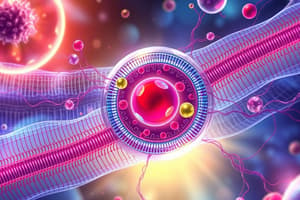Podcast
Questions and Answers
What is the primary function of ribosomes in a cell?
What is the primary function of ribosomes in a cell?
- To transport materials within the cell
- To control all cellular activities
- To synthesize proteins (correct)
- To modify and package proteins
Which organelle is responsible for producing energy through cellular respiration?
Which organelle is responsible for producing energy through cellular respiration?
- Golgi apparatus
- Rough endoplasmic reticulum
- Nucleus
- Mitochondria (correct)
What distinguishes smooth endoplasmic reticulum from rough endoplasmic reticulum?
What distinguishes smooth endoplasmic reticulum from rough endoplasmic reticulum?
- Location in the cytoplasm only
- Involvement in protein modification
- Function in lipid production (correct)
- Presence of ribosomes on the surface
What is the role of the Golgi apparatus in cellular functions?
What is the role of the Golgi apparatus in cellular functions?
Which type of vesicle is specifically known to contain digestive enzymes?
Which type of vesicle is specifically known to contain digestive enzymes?
What is the main function of vacuoles in plant cells compared to animal cells?
What is the main function of vacuoles in plant cells compared to animal cells?
What essential function do nuclear pores serve in a cell?
What essential function do nuclear pores serve in a cell?
Which statement best describes the cytoplasm?
Which statement best describes the cytoplasm?
What is the primary project of the nucleolus within the nucleus?
What is the primary project of the nucleolus within the nucleus?
Animal cells typically contain numerous small vacuoles as compared to plant cells that usually have:
Animal cells typically contain numerous small vacuoles as compared to plant cells that usually have:
Flashcards
Nucleus
Nucleus
The control center of the cell, responsible for all cellular activities. It contains the cell's genetic material (DNA) and directs protein synthesis.
Nucleolus
Nucleolus
A region inside the nucleus where ribosomes are produced.
Rough Endoplasmic Reticulum (RER)
Rough Endoplasmic Reticulum (RER)
An organelle involved in protein synthesis. It has ribosomes attached to its surface.
Ribosomes
Ribosomes
Signup and view all the flashcards
Smooth Endoplasmic Reticulum (SER)
Smooth Endoplasmic Reticulum (SER)
Signup and view all the flashcards
Golgi Apparatus
Golgi Apparatus
Signup and view all the flashcards
Vesicles
Vesicles
Signup and view all the flashcards
Lysosomes
Lysosomes
Signup and view all the flashcards
Vacuoles
Vacuoles
Signup and view all the flashcards
Mitochondria
Mitochondria
Signup and view all the flashcards
Study Notes
Cell Organelles and Their Functions
- Nucleus: Controls cell activities; materials exit through nuclear pores.
- Nucleolus: Region within nucleus where ribosomes are assembled.
- Rough Endoplasmic Reticulum (RER): Attached to the nucleus; studded with ribosomes, crucial for protein synthesis.
- Ribosomes: Dense granules; site of protein synthesis, joining amino acids to form proteins.
- Smooth Endoplasmic Reticulum (SER): Attached to the nucleus; involved in lipid production and packaging.
- Golgi Apparatus: Sorts, folds, and modifies proteins from the RER; uses vesicles for transport.
- Vesicles: Small membrane sacs for transporting materials within or out of the cell.
- Lysosomes: Specific vesicles with digestive enzymes; break down biomolecules and cell parts.
- Vacuoles: Balloon-like vesicles storing water, food, minerals, or wastes; animal cells have many small vacuoles, plant cells usually one large central vacuole.
- Mitochondria: Produces energy (ATP) through cellular respiration, converting carbohydrate energy into usable energy.
- Cytoplasm: Gel-like substance inside the cell membrane; made of water, proteins, lipids, nucleic acids, and salts.
Studying That Suits You
Use AI to generate personalized quizzes and flashcards to suit your learning preferences.




